Discover the Best Board Games for Every Player
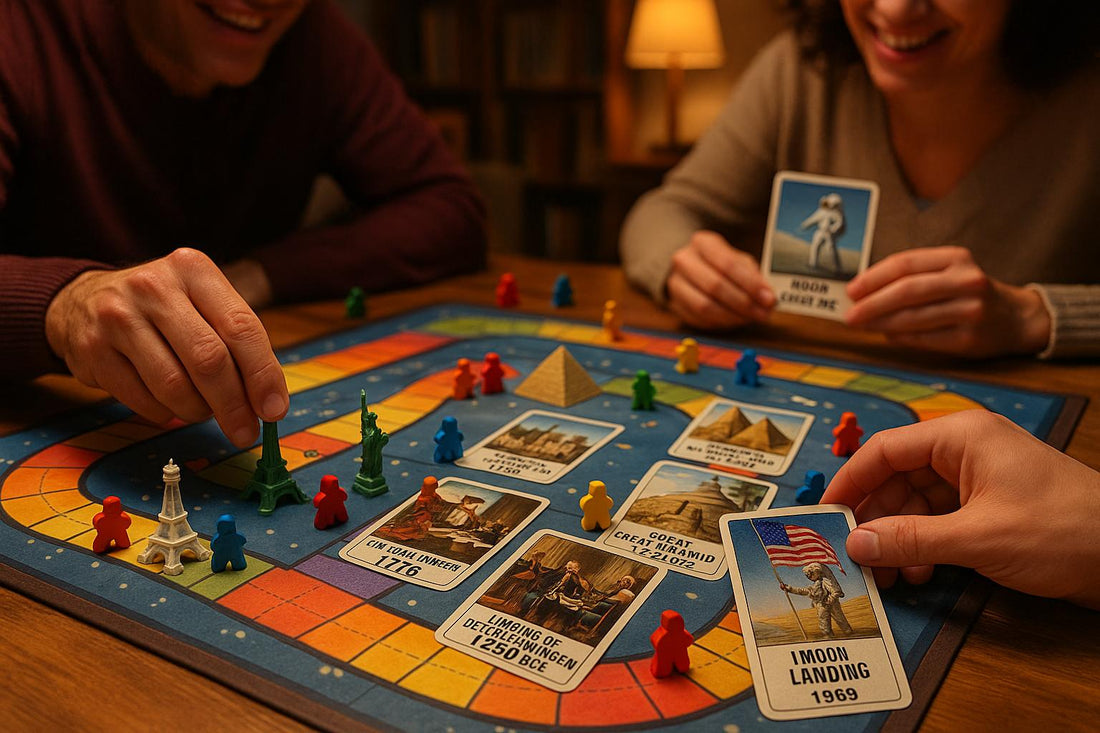
Top 10 Historical Timeline Games
Historical timeline games make learning history fun and interactive. They combine strategy with education, helping players understand historical events and their sequence. Here’s a quick look at the top games that bring history to life:
- Timeline: A simple card game where players arrange events in chronological order. Great for all ages.
- Timeline: American History: Focuses on U.S. history with the same engaging gameplay.
- Timeline Twist: A cooperative version of Timeline that emphasizes teamwork.
- Chronology: Players build a timeline of world events, testing their historical knowledge.
- Trekking Through History: A time-travel adventure exploring global historical events.
- Ancient History Timeline Game for Kids: Designed for young learners, covering events from the Big Bang to the fall of Rome.
- Twilight Struggle: A Cold War strategy game for two players, blending history with geopolitics.
- Commands & Colors: Ancients: A tactical game recreating ancient battles.
- Pax Porfiriana: Set in pre-revolutionary Mexico, players navigate political and social unrest.
- The Republic of Rome: A deep, strategic game simulating Roman politics and governance.
Quick Comparison
| Game | Players | Game Length | Age | Historical Focus | Complexity Level |
|---|---|---|---|---|---|
| Timeline | 2–8 | 15 minutes | 8+ | General historical events | Beginner |
| Timeline: American History | 2–8 | 15 minutes | 8+ | U.S. historical events | Beginner |
| Timeline Twist | 2–6 | 20 minutes | 8+ | General historical events | Beginner |
| Chronology | 1–8 | 30 minutes | 14+ | World historical events | Intermediate |
| Trekking Through History | 2–4 | 60 minutes | 10+ | Various time periods | Intermediate |
| Ancient History Timeline Game for Kids | 2–6 | 20 minutes | 4+ | Ancient civilizations | Beginner |
| Twilight Struggle | 2 | 180 minutes | 13+ | Cold War (1945–1989) | Advanced |
| Commands & Colors: Ancients | 2 | 60 minutes | 12+ | Ancient warfare | Intermediate |
| Pax Porfiriana | 3–6 | 150 minutes | 12+ | Mexican Revolution era | Advanced |
| The Republic of Rome | 1–6 | 240–360 minutes | 14+ | Roman Republic (264–43 BC) | Expert |
Why these games matter: They turn history into an engaging challenge, making it easier to remember events and their context. Whether you’re looking for quick family fun or deep strategic play, there’s a timeline game for everyone.
Timeline Review - with Tom Vasel
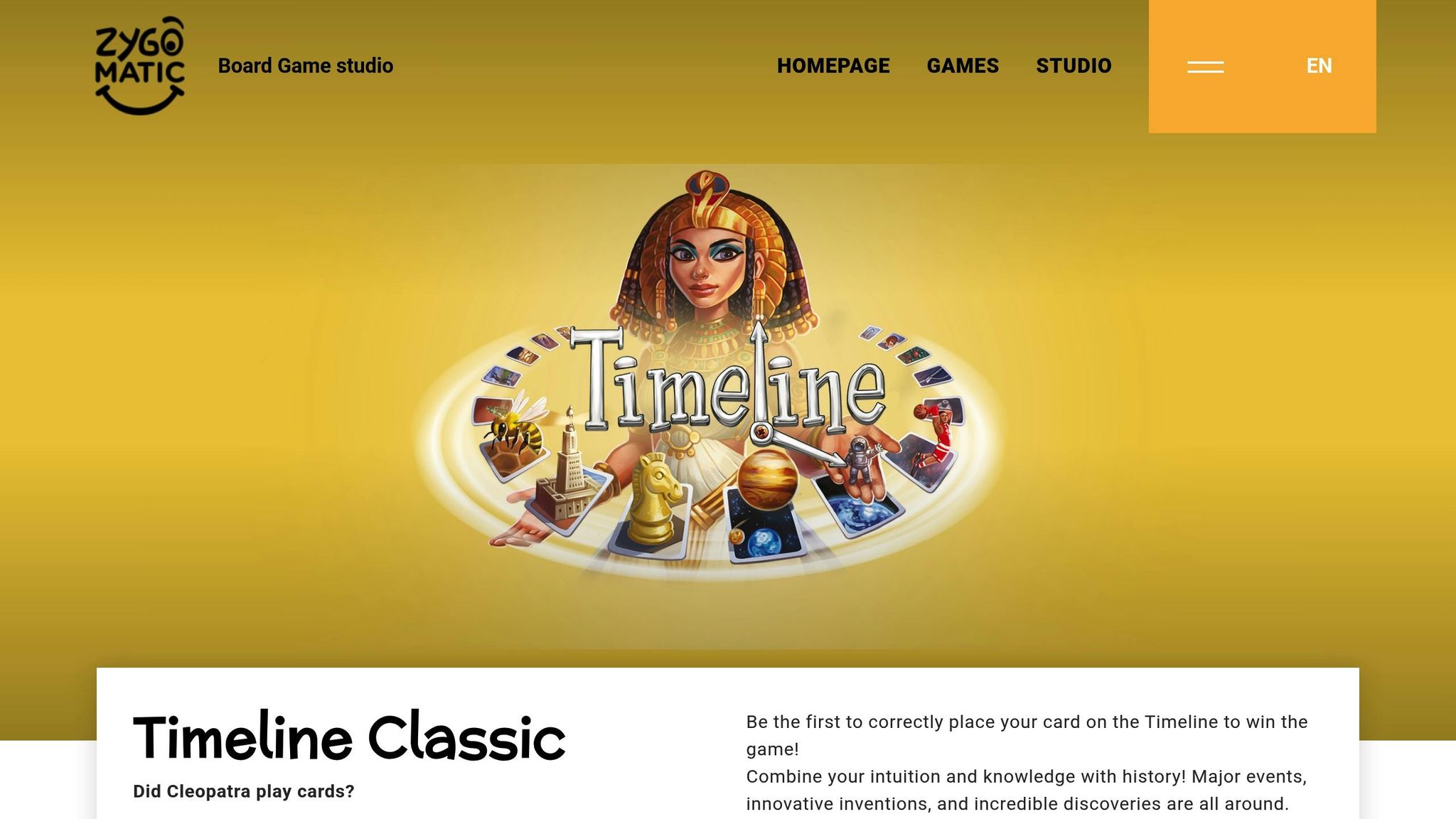
1. Timeline
Timeline is a straightforward and engaging card game that introduces players to historical events in a fun and interactive way. The goal? Arrange events, inventions, and discoveries in the correct chronological order. With its simple rules and short playtime, it’s perfect for anyone looking to combine entertainment with a bit of historical learning.
Historical Scope
The game spans an impressive range of history, covering events from as far back as 5000 B.C.. Think Egyptian pyramids, Roman conquests, and modern technological milestones - all in one game. What’s more, Timeline offers themed versions like Historical Events, Inventions, Discoveries, Diversity, and Music & Cinema. These versions can be mixed together, letting players create a broader and more varied historical experience. This flexibility adds a layer of depth to its otherwise simple mechanics.
Gameplay Mechanics
The gameplay is refreshingly easy to pick up. Each player gets a set of cards with historical events, but the dates on these cards are hidden. Players take turns deciding where their cards fit in the timeline, placing them in chronological order around a face-up card. If the placement is correct, the card stays on the table, revealing its date; if it’s wrong, the card is discarded and replaced. Rounds are quick, lasting about 15 minutes, and the game accommodates 2–8 players.
Educational Value
Timeline transforms learning history from a passive activity into an engaging challenge. Instead of just memorizing dates, players actively think about the sequence of events, which helps improve memory and understanding of historical context. And it’s not just for adults - kids love it too. One Amazon reviewer shared how their 9-year-old enjoyed playing while learning at the same time. The game’s combination of visuals and interaction makes it far more engaging than traditional textbooks, helping players form lasting connections with historical events.
Replayability
One of Timeline’s standout features is its replay value. With multiple themed packs like Science & Discoveries or Music & Cinema, players can keep expanding their historical knowledge. Mixing different sets keeps the game fresh, even after mastering one version. Its quick rounds make it easy to play multiple games in a single session, ensuring it never feels repetitive. The game’s popularity speaks for itself - it has a 4.6 out of 5-star rating on Amazon from 434 reviews. The variety of historical content and the unpredictability of card draws guarantee a unique experience every time you play.
2. Timeline: American History
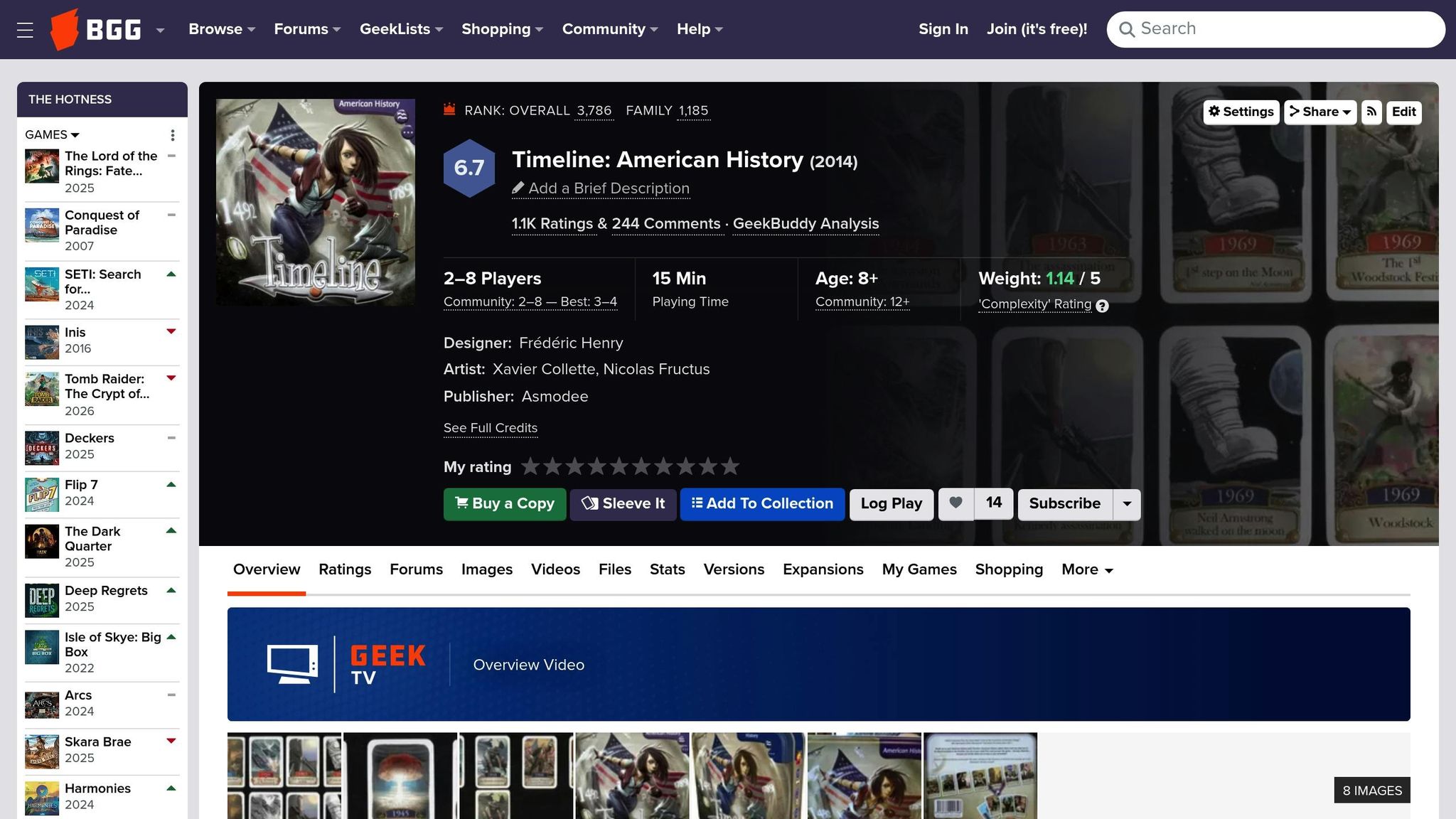
Timeline: American History takes the popular Timeline format and applies it to U.S. history, covering everything from the discovery of the New World to Barack Obama's election as president. This version combines engaging gameplay with a chance to explore key moments in American history.
Historical Scope
The game spans over 500 years of American history, guiding players through events that shaped the nation. From early exploration and colonial settlements to the Revolutionary War and beyond, players encounter pivotal moments that highlight technological advancements, societal changes, and political milestones. This focus on U.S.-specific events creates a distinct experience compared to the global version.
Gameplay Mechanics
The gameplay sticks to the familiar card-placement concept of the Timeline series but narrows its focus to American history. Players start with one card face-up and take turns placing cards with hidden dates into the correct spot on the timeline. If placed correctly, the card's date is revealed; if not, the card is returned to the player's hand. This approach prioritizes understanding the order of events rather than memorizing exact dates. A typical game session lasts about 15 minutes.
Educational Value
Much like the original Timeline, this edition blends fun with learning, helping players grasp the sequence and connections between historical events. It’s particularly effective for children, sparking curiosity and discussions about U.S. history. This makes it a great tool for classrooms or family game nights. Designed for ages 8 and up, it strikes a balance between education and entertainment.
Replayability
One of the game's strengths is its replayability. It works well on its own or combined with other Timeline decks, letting players see how American history fits into a larger global context. Its compact design makes it easy to bring along for travel or quick play sessions, and the straightforward rules mean you can start playing almost immediately. With a BoardGameGeek complexity rating of just 1.14 out of 5, it’s simple enough for beginners yet still packed with historical insights. Repeated play helps reinforce learning, keeping the experience fresh and engaging every time.
3. Timeline Twist
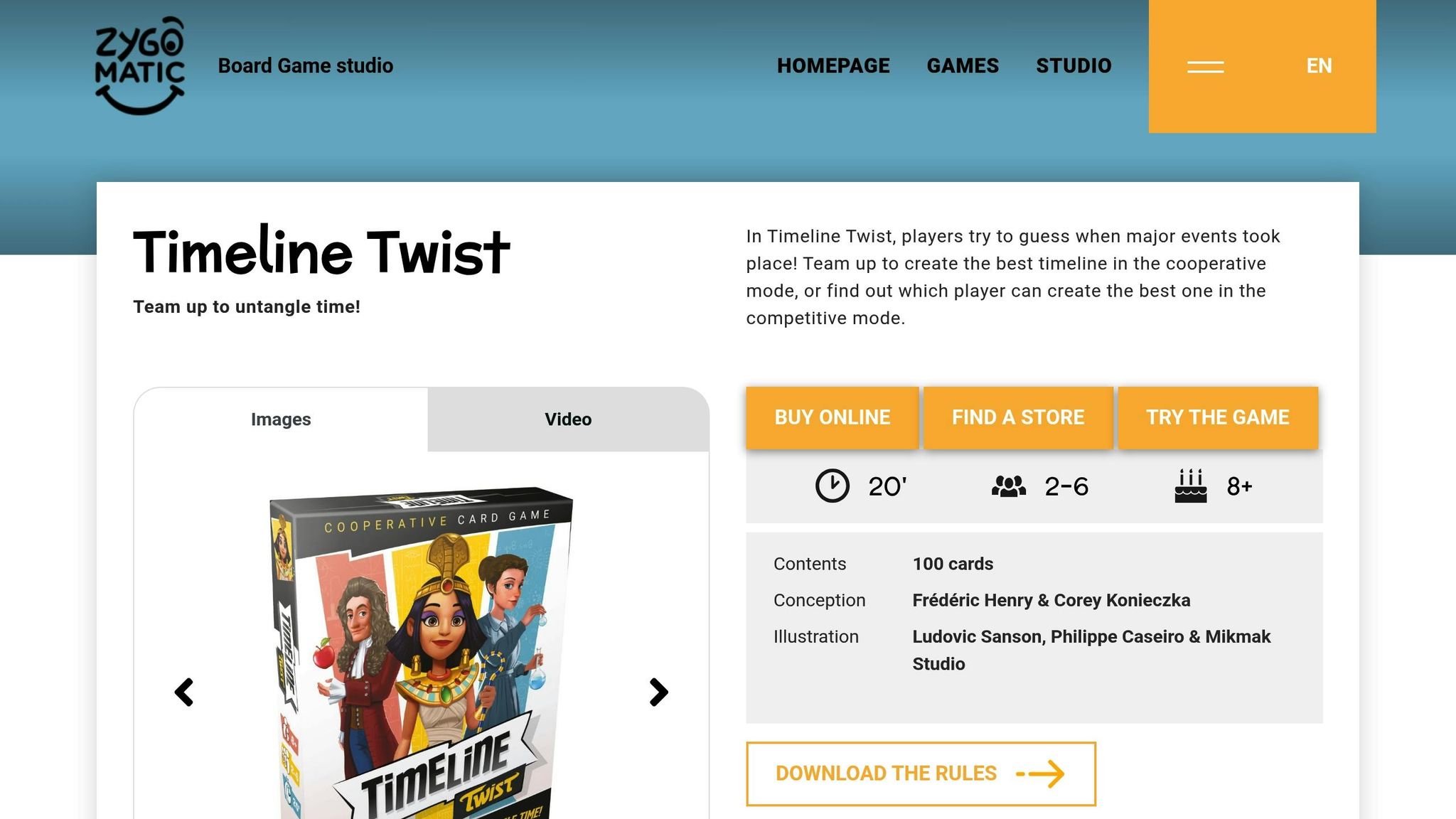
Timeline Twist takes the familiar concept of the Timeline series and gives it a fresh spin by introducing cooperative gameplay. Instead of competing to place cards in the correct chronological order, players now work together, turning individual recall into a team effort. This change brings a whole new layer of strategy and interaction to the game.
Gameplay Mechanics
In this version, the focus shifts from outsmarting opponents to collaborating as a group. The goal is simple: players must work together to play all the cards in their hands by placing events in chronological order or strategically discarding them. Success depends on constant communication and teamwork, as players decide whether to place a card on the timeline or discard it.
The discarding system adds an extra challenge. Players can only discard cards if their icons match the top card in the discard pile, creating a delicate balance between building the timeline and managing discards. Each session uses 36 cards out of the 100-card base set, ensuring that the events vary with each game.
Designed for 2-6 players aged 8 and up, Timeline Twist offers quick, engaging sessions that last about 20 minutes. The game ends when the team either successfully plays all their cards or runs out of legal moves.
Educational Value
While the game remains rooted in the educational goals of the Timeline series, its cooperative design also promotes essential skills like teamwork, communication, and group decision-making. As players discuss historical events and their chronological order, they naturally deepen their understanding of history and its sequences.
This blend of fun and learning hasn’t gone unnoticed - Timeline Twist was nominated for the 2024 UK Games Expo Best Card Game (General). With a complexity rating of 1.29 out of 5 on BoardGameGeek, it’s easy for younger players to jump in while still offering meaningful historical insights.
Replayability
What keeps Timeline Twist fresh is its variety and adaptability. Since only one-third of the available cards are used in each session, the historical events presented change every time. Additionally, the game’s compatibility with other Timeline editions opens up even more possibilities for gameplay.
For those who prefer a different focus, Timeline Twist: Pop Culture shifts the theme to movies, games, and celebrities. And if the group wants a change of pace, players can opt for a competitive mode, where individual knowledge takes center stage. This flexibility ensures the game stays engaging for all kinds of players, session after session.
4. Chronology

Chronology by Buffalo Games takes the timeline concept to the next level, challenging players to do more than just recall dates. Featuring 429 double-sided cards with 858 historical events, the game spans an impressive range of topics, from ancient Greece to modern space exploration.
"Think you know which came first – the invention of mayonnaise or decaffeinated coffee? Lincoln's Gettysburg address or John Deere's first plow? Test your knowledge with Chronology by Buffalo Games – the game of all time!" - Amazon.com
Historical Scope
Chronology divides its events into four engaging categories: Inventions & Discoveries, Sports & Leisure, Arts & Entertainment, and History. This variety ensures that players don’t need to memorize exact dates but instead rely on their understanding of historical order. The mix of familiar and lesser-known events keeps the gameplay fresh and intriguing.
Gameplay Mechanics
Each player starts with two cards placed face up in chronological order. During your turn, a new event is read aloud, and your task is to figure out where it fits within your timeline. Guess correctly, and you keep the card; guess wrong, and the next player gets a shot. The first player to build a timeline of 10 cards wins, though some versions shorten this to 5 cards .
Chronology supports 2 to 8 players, making it great for small or larger groups. Designed for ages 14 and up, it has earned an impressive Amazon rating of 4.8 out of 5 stars based on 3,463 reviews.
Educational Value
This game is more than just fun - it’s a learning experience. Chronology helps players develop a broader understanding of history while reinforcing key dates and events. With every turn, players often uncover surprising gaps in their knowledge, creating opportunities to learn and grow.
Replayability
With 858 unique events, Chronology offers plenty of variety for repeated play. The random card selection ensures that every game unfolds differently, keeping things exciting. Reviews frequently praise the game’s perfect mix of knowledge-testing and chance, making it enjoyable for both history buffs and casual players alike.
5. Trekking Through History
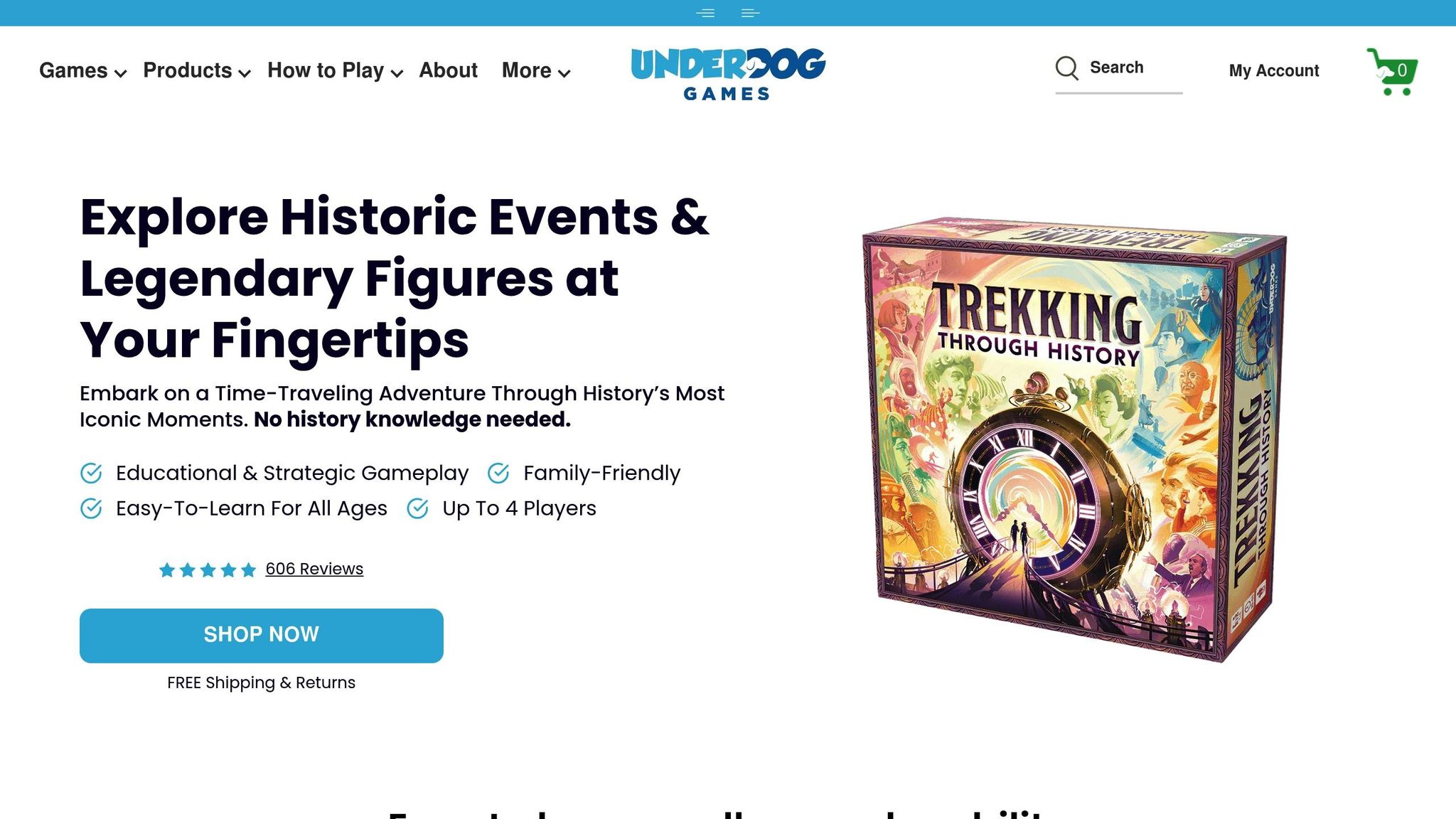
Trekking Through History by Underdog Games takes players on an exciting time-travel adventure through history. This award-winning game, recognized as a Mensa Select Winner in 2023, boasts an impressive 4.6 out of 5 stars on Amazon, based on 729 reviews.
"With Trekking Through History our goal was to transport you to another time and place, to witness the triumphs and heroes that have shaped our world. We hope that it will inspire people to explore the past and spark a lifelong love of history." - Hasan, Creator of Trekking Through History
Historical Scope
The game features 108 historical event cards, spanning from 37,000 BCE to 1994. What sets it apart is its focus on uncovering lesser-known moments in history rather than relying solely on familiar events. This approach invites players to discover and learn something new with each playthrough. The cards highlight real historical figures and events from various continents and time periods, offering a broad and diverse view of history.
Gameplay Mechanics
In Trekking Through History, players become time travelers, drafting event cards from a shared tableau and managing a time cost on a clock board. The game unfolds across three rounds, with each card requiring players to advance their stopwatch marker. Once the marker reaches 12, the round ends.
Each card rewards players with tokens - such as Person, Event, Innovation, Progress, and Wild - that are used to complete itineraries in chronological order. Strategic planning is key, as players must balance their moves carefully to maximize their progress.
"This is an excellent game. Easy to learn, teach, and play. This is a good game for new gamers as well as more experienced players. It doesn't employ a lot of different mechanics, but you do have to be strategic in your choices while playing. Great replayability." - K. B. Drake, Verified Buyer
For those looking for added complexity, the Time Warp expansion introduces special powers that bend the rules of time, offering even more strategic depth. Players can also block their opponents’ moves, adding a competitive edge.
Educational Value
Beyond its engaging gameplay, Trekking Through History shines as an educational tool. Each card is packed with fascinating historical facts, carefully developed in collaboration with historians to ensure accuracy. These details make learning feel effortless and fun, appealing to players of all ages.
Parents and educators particularly value how the game sparks curiosity. Many have noted that children often dive deeper into the historical topics they encounter during gameplay, turning it into a springboard for further learning.
Replayability
With 108 unique event cards and countless strategic possibilities, Trekking Through History offers endless replay potential. The random selection of cards ensures that no two games are alike, and the variety of itinerary cards keeps the challenges fresh. One player even shared that it became a family favorite after just a few sessions.
Its combination of accessible gameplay and educational content makes it a go-to choice for families. At $39.99 (down from $50), it delivers excellent value for a game that entertains and educates in equal measure.
6. Ancient History Timeline Game for Kids
The Ancient History Timeline Game for Kids brings early history to life, covering everything from the Big Bang to the fall of Rome. With 90 historical event cards, it turns learning about chronology into an engaging, hands-on activity for young learners.
Historical Scope
This game covers an impressive range of events, starting with the Big Bang and ending in 476 CE, when the Roman Empire fell. It’s divided into three key periods: prehistoric events before humans, milestones in early human development (like the start of farming), and major advancements from the agricultural revolution to Rome's collapse. Kids can explore fascinating moments like the formation of the solar system, the age of dinosaurs, the invention of writing, and even the creation of paper and silk. By organizing history into clear segments, the game makes it easier for children to grasp the flow of time and key events.
Gameplay Mechanics
The gameplay is simple yet thought-provoking. Each player draws a card featuring a historical event (with the date hidden) and must decide where it fits in the timeline. If they place it correctly, the card stays; if not, they draw another. This approach encourages kids to think critically about how events are connected rather than just memorizing dates. Plus, the timeline builds visually as the game progresses, giving players a tangible sense of historical order.
Educational Value
Beyond just learning dates, this game helps kids understand the bigger picture of history. They’ll start to see how events influence one another, how civilizations rise and fall, and how ideas like farming or writing spread across the world. It’s a fun way to develop analytical skills and make sense of cause-and-effect relationships in history.
"LOVE this game. My 9yo LOVES this game and it is teaching her while she thinks she is just having fun!" - Bobbie, Amazon Customer
Replayability
With 90 cards in the deck, no two games are the same. Each session introduces new combinations of events, offering fresh learning opportunities every time. This variety keeps kids engaged while reinforcing their understanding of historical timelines from different angles.
Parents and teachers also love the game’s flexibility. The cards can double as flashcards for solo study or be used in memory games to strengthen recall. Whether in a group setting or one-on-one, this game adapts to different learning styles and makes history fun.
sbb-itb-1ed942f
7. Twilight Struggle
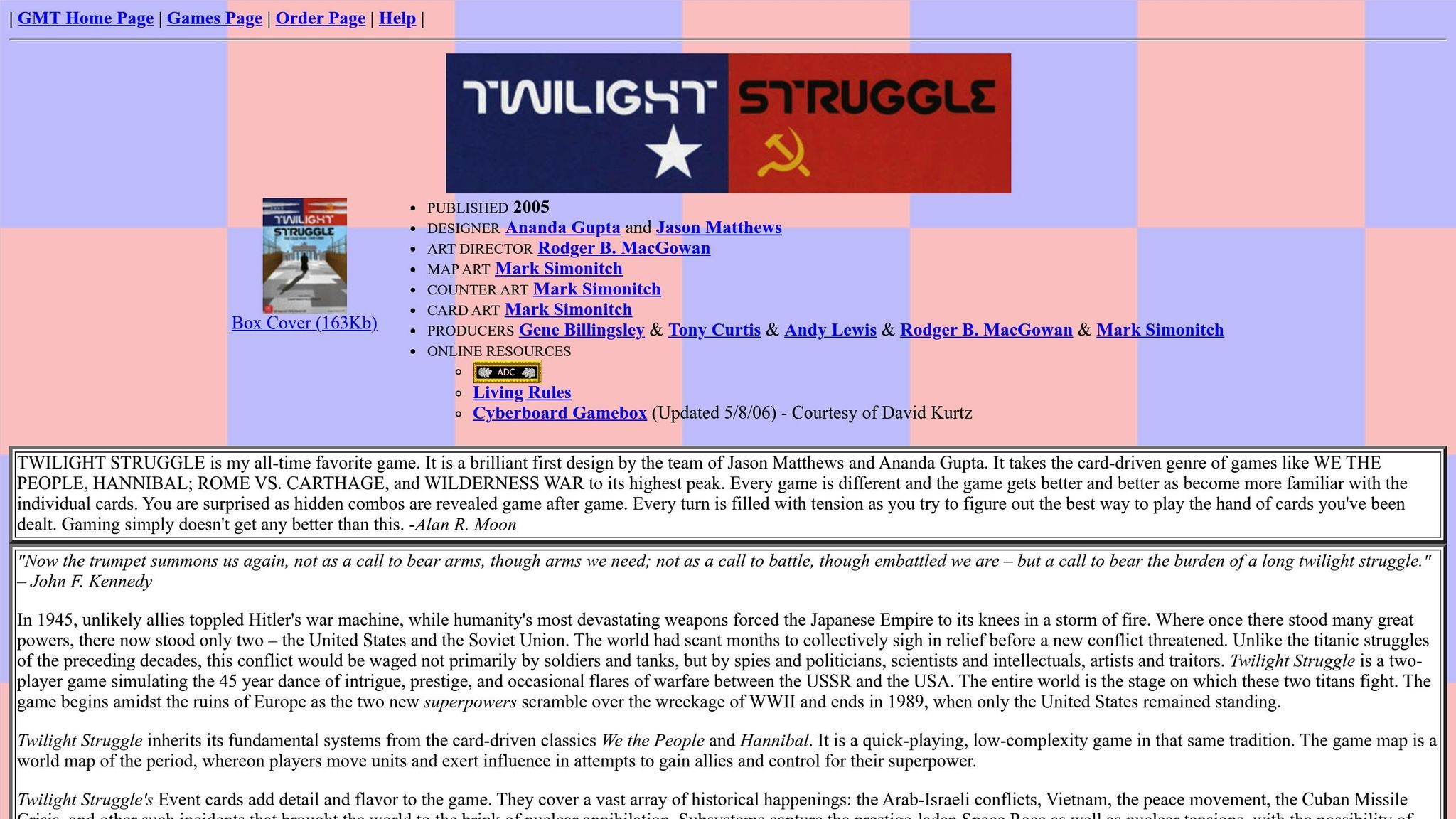
Twilight Struggle stands out among historical timeline games by blending strategic depth with a focus on Cold War-era tensions. This two-player game distills the complexities of the Cold War into a gripping experience. From 2010 to 2015, it dominated the top spot on BoardGameGeek.com and has sold over 135,000 copies globally. Its combination of historical detail and engaging mechanics draws players into the geopolitical drama of the mid-20th century.
Historical Scope
Twilight Struggle spans the Cold War period from 1945 to 1989, capturing the ideological and geopolitical rivalry between the United States and the Soviet Union. The game unfolds across three distinct phases of the Cold War, incorporating pivotal events like NATO's formation, the Cuban Missile Crisis, and Margaret Thatcher's rise to power.
What sets Twilight Struggle apart is how it mirrors the Cold War's unique logic. Players are immersed in the era's binary worldview, where escalating mistrust and brinkmanship defined international relations. The game’s cards, each representing a real historical event or figure, drive the narrative and gameplay, making history an integral part of the experience.
Gameplay Mechanics
Twilight Struggle uses a card-driven system that puts players in the shoes of Cold War leaders. Each card can trigger historical events or serve as a strategic resource. However, playing an opponent's card activates its effects, forcing players to weigh immediate benefits against potential long-term consequences.
The DEFCON track adds another layer of tension, reflecting the ever-present threat of nuclear war. Actions like staging coups in battleground countries can lower the DEFCON level, limiting options and pushing players closer to global catastrophe.
Players use operational points to influence regions, realign alliances, or stage coups, simulating the strategies employed by the superpowers. The Space Race offers a unique twist, allowing players to discard troublesome cards while earning points - an apt nod to the technological competition of the era. Meanwhile, regional scoring cards keep the pressure high as players compete for dominance in key areas, echoing the global stakes of Cold War rivalries.
Educational Value
Beyond its strategic appeal, Twilight Struggle serves as an educational tool, offering a nuanced view of Cold War dynamics. The game immerses players in the mindset of the era, encouraging them to think like Cold War leaders rather than just presenting historical facts. Even without prior knowledge, players are guided to make decisions that align with the period’s historical context. By navigating the delicate balance of brinkmanship and ideological competition, players gain insight into how close the world came to disaster during this tense period.
Replayability
Twilight Struggle’s card-driven mechanics and varied strategies ensure that no two games play out the same way. The diverse deck of event cards and the balance between short-term tactics and long-term planning create fresh challenges every time. Its zero-sum structure, where one superpower’s gain is the other’s loss, mirrors the real-life stakes of Cold War geopolitics. Each playthrough offers a new perspective on this fascinating chapter of history, keeping players coming back for more.
8. Commands & Colors: Ancients
Commands & Colors: Ancients brings ancient warfare to life with a perfect balance of strategy and accessibility. Designed by Richard Borg and published by GMT Games, it has earned top ratings - 5/5 from The Boardgames Chronicle and a stellar 10/10 on BoardGameGeek. This game bridges the gap between detailed historical wargames and approachable family games, making the rich history of ancient military conflicts enjoyable for players of all experience levels.
Historical Scope
This game spans a remarkable timeframe, covering battles from the Dawn of Military History (3000 BC) through the early Middle Ages (400 AD). Players can explore how ancient combat evolved over thousands of years.
"Commands & Colors: Ancients depicts warfare from the Dawn of Military History (3000 BC) to the opening of the Middle Ages (400 AD). Quite an ambitious undertaking for one game, yet Commands & Colors by design is a unique historical game system which allows players to effectively portray stylized battles from this time in history. The 15 battles, showcased in the scenario booklet, although stylized, focus on important terrain features and the historical deployment of forces in scale with the game system. The battles include Bagradas, Cannae, and Zama." – GMT Games
The base game includes 15 iconic battles such as Bagradas, Cannae, and Zama. Each scenario is designed with authentic terrain and troop deployments, offering players a chance to engage with history while testing their tactical skills.
Gameplay Mechanics
At its core, Commands & Colors: Ancients uses a card-driven system. Players rely on command cards to activate units across a battlefield divided into three sectors: Right Flank, Center, and Left Flank. This setup mirrors the challenges of coordinating forces across a dynamic battlefield.
Combat is resolved with special dice that can result in kills, retreats, or no effect. Terrain features like hills, forests, rivers, and villages add complexity by influencing movement and line of sight. The game includes a wide array of ancient units - infantry, cavalry, chariots, elephants, and missile troops - each with distinct strengths, weaknesses, and abilities that reflect their historical counterparts.
"The scale of the game fluctuates from battle to battle. For some scenarios, an infantry unit may represent a legion of fighters, while in other scenarios a unit may represent just a few brave warriors. But the tactics you need to execute conform remarkably well to the advantages and limitations inherent to the various units, their weapons, terrain and time." – GMT Games
This dynamic system keeps gameplay fresh and ensures that tactics remain central to every decision.
Educational Value
Commands & Colors: Ancients doesn’t just entertain - it teaches. By reflecting the strengths and weaknesses of ancient units, the game offers players a deeper understanding of military tactics from the era.
"The game mechanics, although simple, will still require strategic card play, historical tactics, timely dice rolling, and an aggressive yet flexible battle plan, to achieve victory." – Richard Borg
From managing diverse unit types to leveraging terrain, players experience the same challenges that ancient commanders faced. It’s a hands-on way to learn about history while enjoying an engaging game.
Replayability
The combination of card-driven mechanics and a variety of historical scenarios ensures that no two games play out the same way. Tactical decisions and card draws create endless possibilities, keeping players coming back for more. Plus, expansions and additional scenarios open the door to even more ancient conflicts, making this game a treasure trove for history and strategy enthusiasts alike.
9. Pax Porfiriana

Pax Porfiriana transports players to the turbulent Porfiriato era in Mexico, spanning from 1876 to 1911. With a 7.7/10 rating on BoardGameGeek, this game has received nominations for the Golden Geek Awards in categories like Most Innovative Board Game and Best Thematic Board Game. Its focus on this pivotal historical period lays the groundwork for an engaging and deeply strategic experience.
Historical Scope
The game delves into the Porfiriato era, when Porfirio Díaz ruled Mexico for 35 years across seven terms. While Díaz's reign appeared stable on the surface, it masked deep social and political unrest.
"The Mexican Revolution stripped away the veneer of order and peace - the Pax Porfiriana - that had masked the social unrest percolating beneath the surface of President Díaz's long reign." - Beth Ann Guynn, Getty Research Institute, Los Angeles
This tension culminated in the Mexican Revolution, which officially began on November 20, 1910, when Francisco Madero issued the "Plan of San Luis Potosí", challenging Díaz's dictatorship. The game captures this volatile pre-revolutionary period, immersing players in its complexities.
Gameplay Mechanics
In Pax Porfiriana, players take on the roles of hacendados - wealthy landowners and businessmen - vying to build powerful empires while navigating the era's volatile political landscape. The gameplay revolves around a central card market, where players buy and deploy cards to shape their strategies. With only 50 of the 220 available cards used per game, every session offers a fresh and unpredictable experience.
The card market is designed with escalating costs by row, creating a constant tension between short-term gains and long-term planning. Players can construct ranches, mines, railroads, and banks, recruit troops, and even sabotage rivals using bandidos, Native American allies, or lawsuits.
A standout feature is the unrest mechanic, which represents societal disruptions caused by union activists, prohibition leagues, and revolutionaries. Players can manipulate these disruptions to their advantage, even resorting to underhanded tactics like paying off unionists to extort their own enterprises if it aligns with their broader goals.
Victory isn’t just about amassing wealth. Players must choose one of four paths to overthrow Díaz: military coup, succession, revolution, or U.S. annexation. Each path ties to specific Victory Point types, challenging players to align their strategies with their chosen route to power.
Educational Value
Pax Porfiriana doesn’t shy away from the era’s historical complexities. For instance, the game includes slavery mechanics, where plantations cost less than ranches, reflecting the harsh reality of Yaqui slavery in Sonora. Players must navigate the intricate web of pre-revolutionary interests, including foreign investments, industrial growth, indigenous rights, and labor movements. These mechanics push players to grapple with moral dilemmas and political trade-offs that mirror the challenges of the time.
Replayability
With only 50 cards drawn from a pool of 220 in each game, no two sessions are alike. The variable market and multiple paths to victory ensure endless strategic possibilities, requiring players to adapt to shifting circumstances. The game’s complexity rating of 3.64/5 makes it particularly appealing to experienced players, who will discover new layers of strategy and nuance with every playthrough. Each combination of cards and political dynamics creates a unique scenario, keeping the game fresh and engaging over time.
10. The Republic of Rome
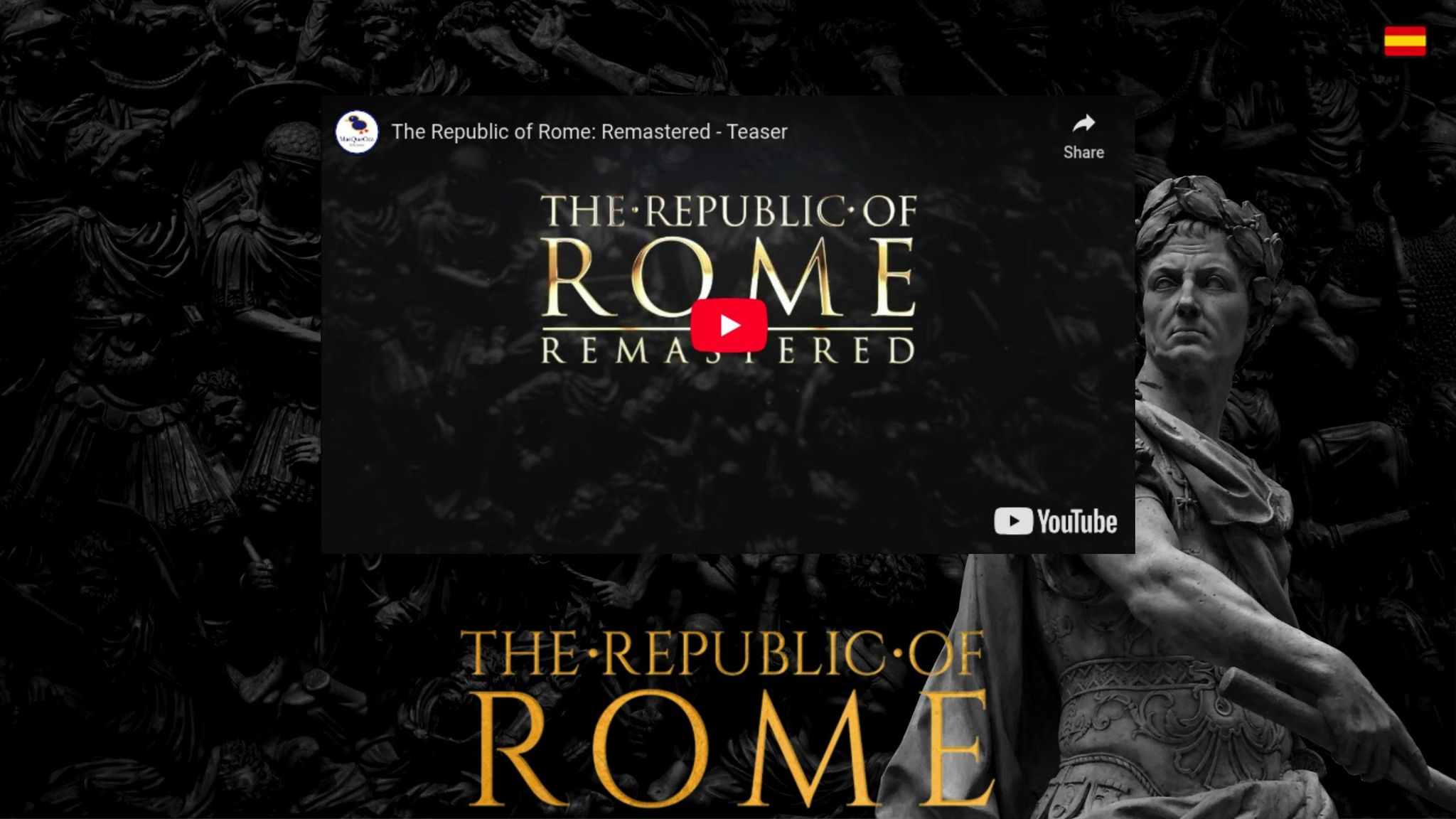
The Republic of Rome is a political simulation game that takes players deep into the heart of the Roman Republic, spanning the years 264 BC to 43 BC. With a BoardGameGeek rating of 7.5/10 and a complexity score of 4.37/5, this Origins Award-winning game has captured the attention of strategy enthusiasts and history buffs alike.
Historical Scope
The game immerses players in the period between the First Punic War and the Alexandrine Wars, highlighting key military achievements and the political turbulence of the Roman Republic. While the game takes creative liberties - such as inventing a "Rome Consul/Field Consul" division and simplifying roles like the Dictator and Censor - it still captures the essence of the era. As one reviewer, Michael, aptly put it:
"But as is often the case with thematic games, the veneer of historicity disappears if one drills down into the details. Yet, despite the obvious inaccuracies, few would contest that Republic of Rome is anything but deeply evocative."
Gameplay Mechanics
At its core, The Republic of Rome revolves around players managing senatorial factions. These factions compete for influence by securing state offices, commanding armies, and gaining economic advantages - all while defending Rome from external threats. The game incorporates a Senate approval system, where actions are penalized if approval falls below 51% and outright prohibited under 30%. This adds a layer of strategic depth, as players must navigate the political landscape carefully.
One of the most intriguing aspects of the game is its binding negotiation system:
"Negotiation in The Republic of Rome is binding. If you make a promise, the rules of the game force you to keep it. You cannot break a deal." – Erik Twice
This mechanic, coupled with random events like senator deaths and military disasters, ensures that the gameplay mirrors the unpredictability of Roman politics.
Educational Value
Beyond its entertainment value, the game offers a nuanced portrayal of Roman political institutions and the influence of elite factions on governance. Unlike many historical games that focus solely on military campaigns, The Republic of Rome emphasizes the political and social dynamics that contributed to the Republic's eventual decline. Its 4–6 hour playtime allows players to fully engage with these complex systems, offering an immersive experience.
Replayability
What sets this game apart is its variety of victory conditions. Players can win by building traditional influence or orchestrating a bold coup, with strategies that shift depending on alliances and player interactions. Random events and the binding negotiation system ensure that no two sessions are alike, reflecting the ever-changing and volatile nature of Roman politics.
With its blend of strategy, historical themes, and unpredictable gameplay, The Republic of Rome offers a compelling look into one of history's most fascinating periods.
Game Comparison Chart
Finding the right historical timeline game for your group depends on what you're looking for - preferences, time constraints, and experience all play a role. The chart below highlights key details to help you make the best choice.
| Game | Players | Game Length | Age | Historical Focus | Complexity Level |
|---|---|---|---|---|---|
| Timeline | 2–8 | 15 minutes | 8+ | General historical events | Beginner |
| Timeline: American History | 2–8 | 15 minutes | 8+ | U.S. historical events | Beginner |
| Timeline Twist | 2–6 | 20 minutes | 8+ | General historical events | Beginner |
| Chronology | 1–8 | 30 minutes | 14+ | World historical events | Intermediate |
| Trekking Through History | 2–4 | 60 minutes | 10+ | Various time periods | Intermediate |
| Ancient History Timeline Game for Kids | 2–6 | 20 minutes | 4+ | Ancient civilizations | Beginner |
| Twilight Struggle | 2 | 180 minutes | 13+ | Cold War (1945–1989) | Advanced |
| Commands & Colors: Ancients | 2 | 60 minutes | 12+ | Ancient warfare | Intermediate |
| Pax Porfiriana | 3–6 | 150 minutes | 12+ | Mexican Revolution era | Advanced |
| The Republic of Rome | 1–6 | 240–360 minutes | 14+ | Roman Republic (264–43 BC) | Expert |
Understanding Complexity Levels
- Beginner: Quick to learn with straightforward rules, ideal for new players.
- Intermediate: Offers more depth and requires some strategic planning.
- Advanced: Features intricate mechanics and takes time to master.
- Expert: Highly detailed systems that demand patience and dedication.
The chart lays out the essentials, making it easier to find a game that matches your group’s dynamics and schedule.
The Timeline series is perfect for families or those just dipping their toes into historical games, thanks to its simplicity and quick gameplay. If you're in a classroom setting, Chronology is a standout choice. It’s adaptable for both beginners and history buffs, and teachers often enhance the experience by encouraging players to share card details aloud.
When it comes to age recommendations, there's room for flexibility. Pairing players with different experience levels can create balanced teams and add an educational twist. Game lengths range from breezy 15-minute rounds to marathon sessions lasting up to six hours - just pick one that fits your timeline.
For some games, historical events are paired with engaging storytelling or thematic elements, making the learning experience even more enjoyable.
Conclusion
Historical timeline games blend learning with entertainment by allowing players to actively engage with history rather than passively consuming it through textbooks or documentaries. This interactive approach significantly enhances how well players absorb and retain knowledge.
Studies back this up: game-based learning has been shown to improve retention and exam performance. For instance, research from WestEd found a 25 percentile point increase in performance after 50+ gaming sessions. With nearly three-quarters of U.S. kids playing video games, it's clear this method resonates. These games tap into intrinsic motivation, sparking curiosity about historical events. Plus, their use of visual and multi-sensory elements boosts understanding, while active involvement strengthens memory by reinforcing neural pathways.
Professor Andrew Denning from the University of Kansas highlights the broader impact of historical games:
"Historical video games connect the past to present, shaping historical memory and contemporary political debates simultaneously. Video games are a form of 'deep play' that build knowledge of the past and present, but that knowledge must be broadened through historians' attention to structural forces and disadvantaged groups."
These games transform learning into an exciting challenge, offering both quick bursts of fun and deeper, strategic engagement. Whether you’re enjoying a 15-minute family game of Timeline or diving into a six-hour session of The Republic of Rome, these experiences fit perfectly into classrooms, family game nights, or strategy-focused gatherings.
Curious to explore history through gaming? Check out Brain-Games.com for published titles or visit Brain-Games.lv/en/ for their full collection.
FAQs
How do historical timeline games enhance learning compared to traditional methods?
Historical timeline games bring history to life by pulling players into pivotal events and encouraging hands-on involvement. This interactive style not only deepens understanding of how events are connected but also helps players remember the sequence of historical milestones more effectively.
On top of that, these games challenge players to think critically and make decisions by evaluating scenarios within their historical contexts. Many of them also encourage teamwork and communication, offering a chance to build social skills while working collaboratively. In short, timeline games offer an engaging and dynamic way to learn, breaking away from traditional methods.
How do different game complexities impact the learning experience for various age groups?
The Role of Complexity in Historical Timeline Games
The level of complexity in historical timeline games significantly influences how players of different ages engage with and learn from them. For younger audiences, games with straightforward rules and simple mechanics work best. These games introduce basic historical ideas without overwhelming players, often focusing on skills like sequencing and basic strategies. This approach makes learning about history both accessible and enjoyable.
On the other hand, older players thrive with games that involve more intricate strategies and complex decision-making. These advanced games encourage critical thinking and analytical skills, prompting players to connect historical events to larger contexts. By catering to a range of difficulty levels, historical timeline games create an inclusive and enriching experience for learners of all ages.
Can historical timeline games help students learn history in the classroom?
Historical timeline games offer an engaging way to teach history in classrooms. By turning lessons into interactive experiences, these games help students grasp and remember historical events and concepts more effectively. They immerse players in historical scenarios, encouraging critical thinking, teamwork, and a deeper understanding of the complexities of the past.
Using these games in lessons also boosts participation, making history feel more relevant and enjoyable. They provide a hands-on opportunity to examine events, decisions, and their ripple effects - something traditional teaching methods often struggle to achieve.






